Several months ago, after so many years of dreaming, I finally got the chance to visit ancient Roman ruins for the very first time in Baalbek, Lebanon. Due to their sheer size, the city’s Temple of Jupiter and Temple of Bacchus are considered the largest religious structures ever built in the Roman world, even bigger than those in Italy. “How can you visit other Roman ruins after this?” James told me, amused and concerned at the same time. Several months after that first trip to the Middle East, I posted this information on my social media account, and an acquaintance replied with a question. “Are they even bigger than the ruins in Jerash?”
There’s only one way to find out, and that is by seeing the latter with my own eyes – which happened last month when I fulfilled a long-held wish to visit Jordan, a country where the ancient city of Jerash is located.
The drive from downtown Amman to Jerash takes us through rolling hills which become greener as we move further north toward one of Jordan’s most-treasured heritage sites. The ancient village of Garshu (from which the Roman name Gerasa and Arabic name Jerash were derived) fell under the control of the Greeks in the fourth century BC when Alexander the Great settled his old soldiers there. The Greeks remained in control of this place for more than two centuries until the arrival of the Roman army in 63 BC after occupying Baalbek and its surrounding areas a year earlier. Under Roman rule, Gerasa continued to thrive and joined nine other cities in the region to form the Decapolis – a group of autonomous city-states in the eastern frontier of the Roman Empire. However, unlike the Romans who came to this city from the north, we take a southern approach.
Around one hour after leaving Amman, we arrive in modern Jerash, a city of around 50,000 people. A large, imposing gate stands at the southern end of the city’s archaeological park, welcoming visitors to the expansive site. It is the Arch of Hadrian, built to honor the visit of the namesake Emperor to Gerasa in the second century AD. We walk through this magnificent gateway and find the ruins of a hippodrome to our left, with no large-scale structures for another 400 meters straight ahead, where the South Gate stands. That monument is believed to be a prototype for the bigger, more elaborate Arch of Hadrian. Historians view the latter’s distance from the actual gateway to ancient Jerash as evidence of a plan to expand the city southward – a plan that never got off the drawing board.
Past the original entrance to the city is the Oval Forum, a monumental plaza surrounded by Ionic columns that marks the southern end of the Cardo – the main street of Gerasa which formed the city’s primary axis. 800 meters away at the northern end of the colonnaded Cardo lies the North Gate, with many of the city’s most important structures built along this stretch of this north-south center line. On higher ground behind the Oval Plaza sits the Temple of Zeus, a once stately shrine commissioned in the second century AD as the city’s main place of worship. Its location was an extension of a terrace directly below it which had been used as a sanctuary for the god of the sky, lightning and thunder prior to the construction of the temple. Overlooking the entire ancient city, the Temple of Zeus was in fact built 15 years after the construction of another temple situated on one of the highest points in the city dedicated for Artemis, the goddess of the hunt, the wilderness, wild animals, the Moon, and chastity. The fact that two major temples were built in the city tells of a struggle between those who held positions of power in Gerasa – pitting the Hellenistic part of the population that preferred the goddess against the Semitic inhabitants who venerated the sky god more – resulting in two competing cults.
No Roman or Greek city would be complete without a large theater, and Gerasa had not one, nor two, but three. The biggest of them – the South Theater which lies next to the Temple of Zeus – offers a sweeping view of the entire ancient city with the remnants of the Temple of Artemis rising above all other structures in its vicinity. Meanwhile, the modern part of Jerash rises to the east of the archaeological complex, built literally on top of much older buildings, adding to the area’s already rich layers of history. From this vantage point I realize what my friend was saying about the size of Jerash; while its individual structures are nowhere near as colossal as the ones in Baalbek, when seen in its entirety the ancient city of Jerash is expansive with multiple temples and theaters, a long Cardo, an iconic plaza, and splendid gateways strewn all over the ancient city.
We return to the Oval Plaza and begin our walk through the Cardo, handsomely flanked by Ionic and Corinthian columns on both sides. A few minutes later we arrive at the remains of the South Tetrapylon, four pedestals upon which four columns used to stand, built at the intersection of the Cardo and the South Decumanus (a main road running from east to west).
We continue ambling down the stone-paved road, some parts of it bearing the telltale grooves left by horse carriages from almost two thousand years ago, while others provide a resting place for fallen columns. Multiple earthquakes had in fact caused extensive damage to Gerasa, contributing to its eventual demise. The largest of those occurred in the year 749 which rattled many cities along the western and eastern banks of the Jordan River, leaving an extensive trail of destruction. Today, modern visitors in Jerash can still see the impact of this brute force of nature upon once-prosperous Gerasa. This state of damage was further exacerbated by the conquest of the city by different foreign powers, and before then, major modifications under the Byzantines, who reused many collapsed parts of the Roman structures to build churches across the city.
Among the buildings constructed during this period were the Cathedral and the Church of St Theodore, both situated next to the grand staircase that leads to the Temple of Artemis. Not much is left from the former two, except for several columns and walls that still stand against all odds. However, crosses carved in stone in these ruins speak of a shift in the locals’ beliefs following the adoption of Christianity as the state religion of the Roman Empire. Elsewhere within the archaeological compound are vestiges of the Umayyads, the Abbasids and the Ottomans – successive Muslim dynasties that ruled Jerash following Islam’s rapid expansion throughout the Middle East and North Africa since its inception in the seventh century AD.
I climb the stairs toward the Temple of Artemis under the scorching sun, and stumble upon a small snake that is trying to get into a small crack under one of the steps to escape the heat. A little farther on, I arrive at a wide rectangular courtyard bordered by a few columns; the main temple stands close to the western side of the perimeter. In its heyday, when all the columns were intact, as was the entablature and pediment perched atop the sanctuary, all of this must have looked so elegant and magnificent. It is said that this temple was built to be the most beautiful of all places of worship in Gerasa. But even today, with only a fraction of its original structure still standing, the Temple of Artemis remains an impressive sight. Dwarfed by its millennia-old pillars, I look up and I’m immediately reminded of what I felt when I was at the Temple of Bacchus in Lebanon: being astonished, enthralled, and humbled at the same time.
From the Temple of Artemis we walk farther past the North Theater, and the North Tetrapylon, before eventually reaching the North Gate which marks the very end of the entire archaeological site. Not all tourists make their way toward this northern end point, giving this part of the complex a much quieter ambiance than the area around the South Gate. Here, James and I marvel at the remarkable ancient structures and stone blocks around us, before turning around for one final walk down the Cardo, this time from north to south, the exact same direction the traders and other people of ancient Gerasa traveled to reach another Decapolis city-state: Philadelphia, a place we know today as Amman.

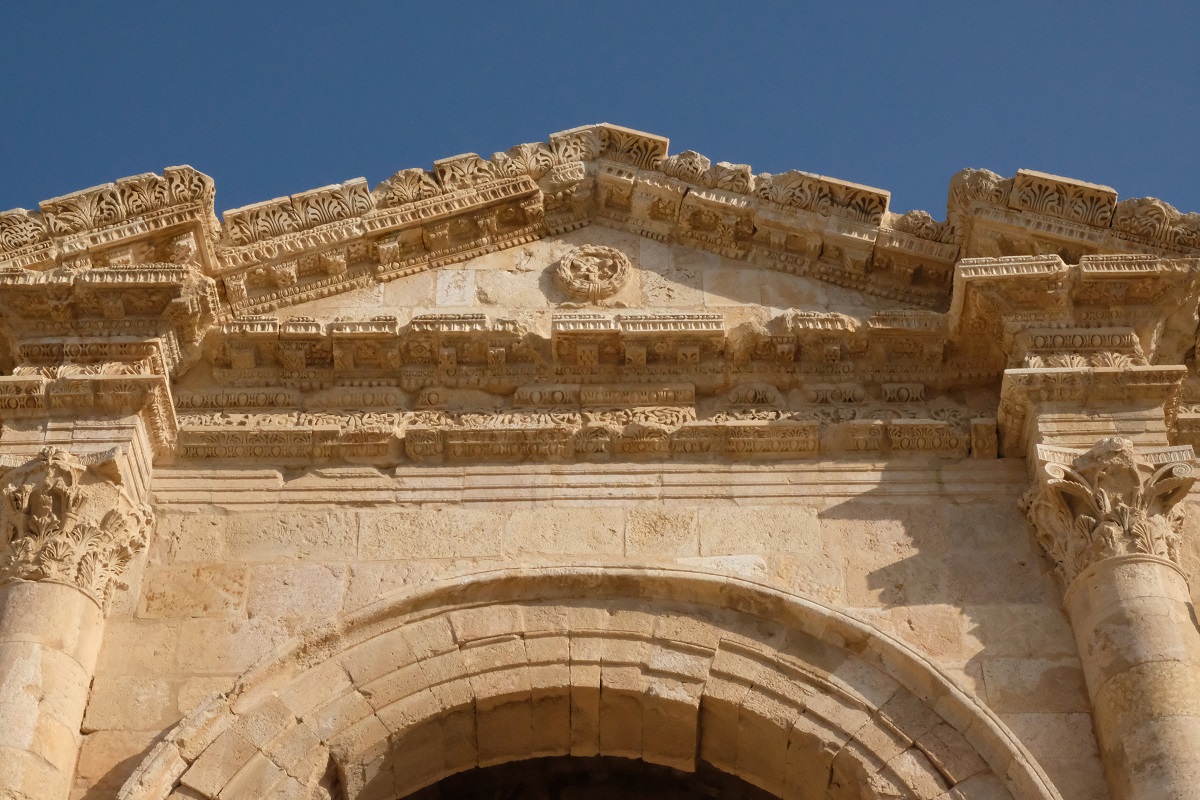



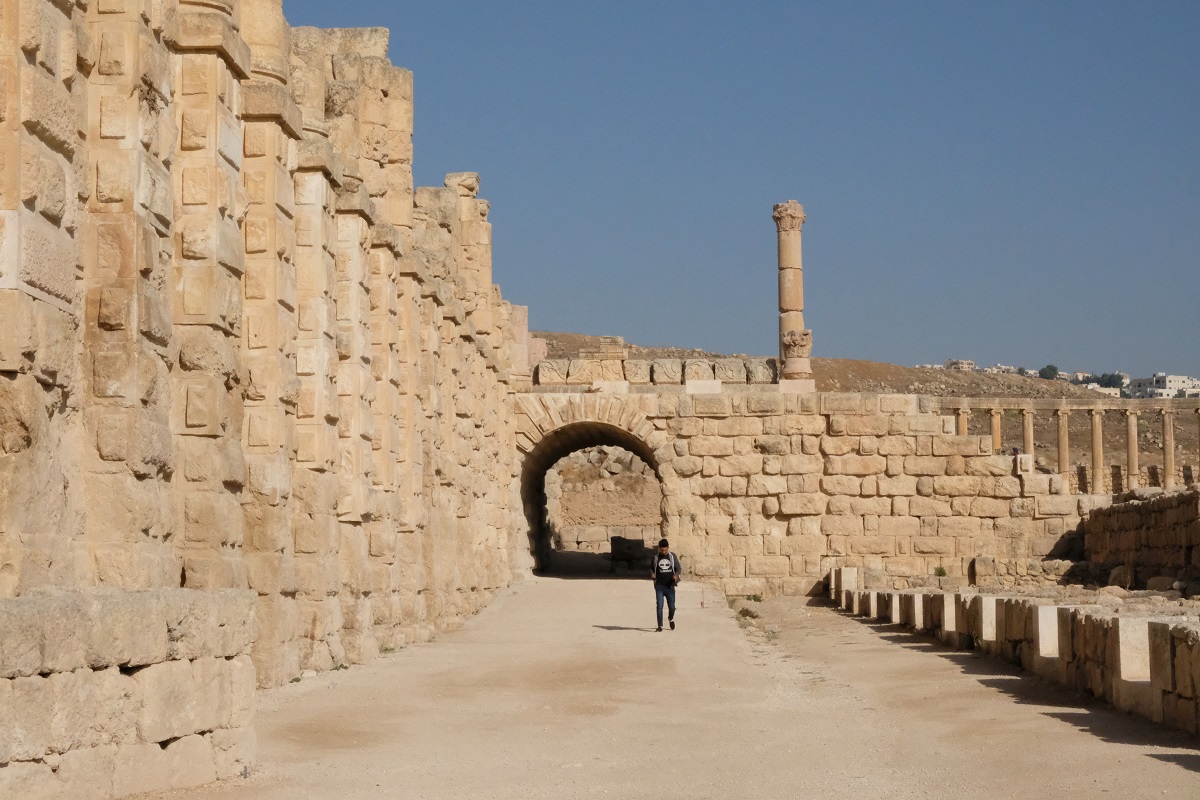



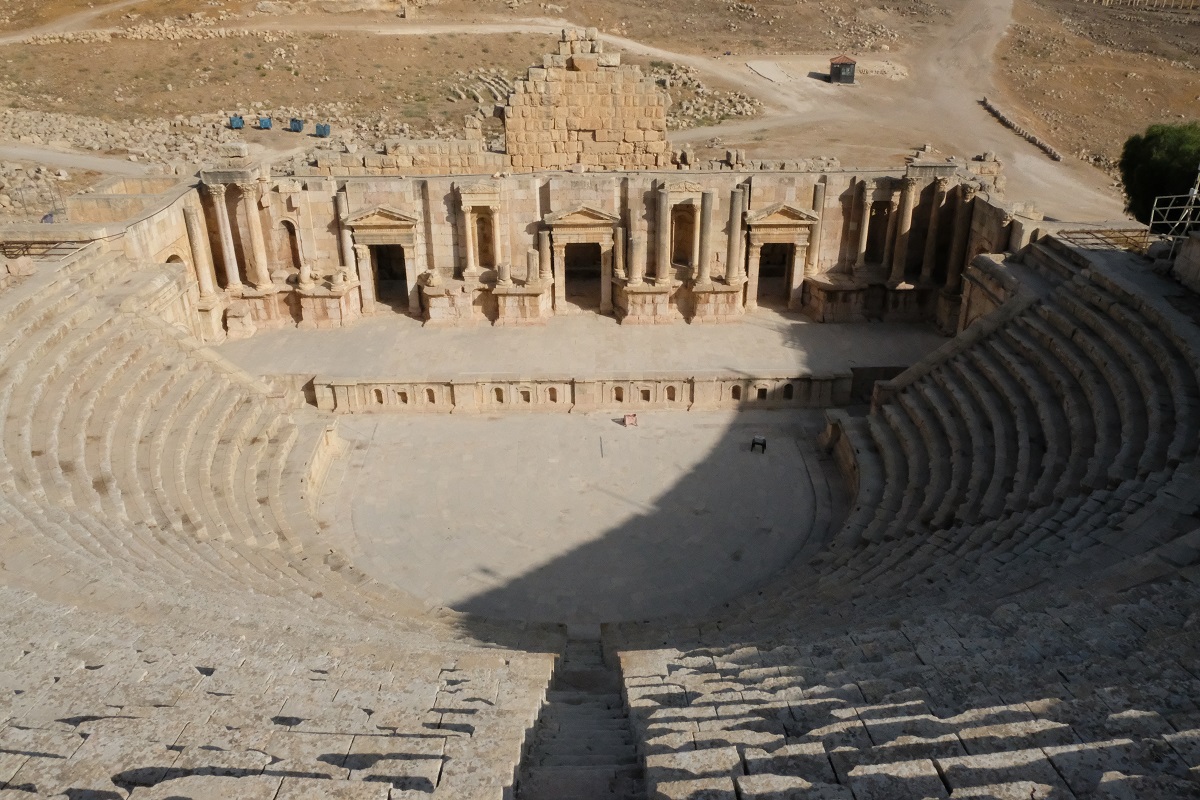

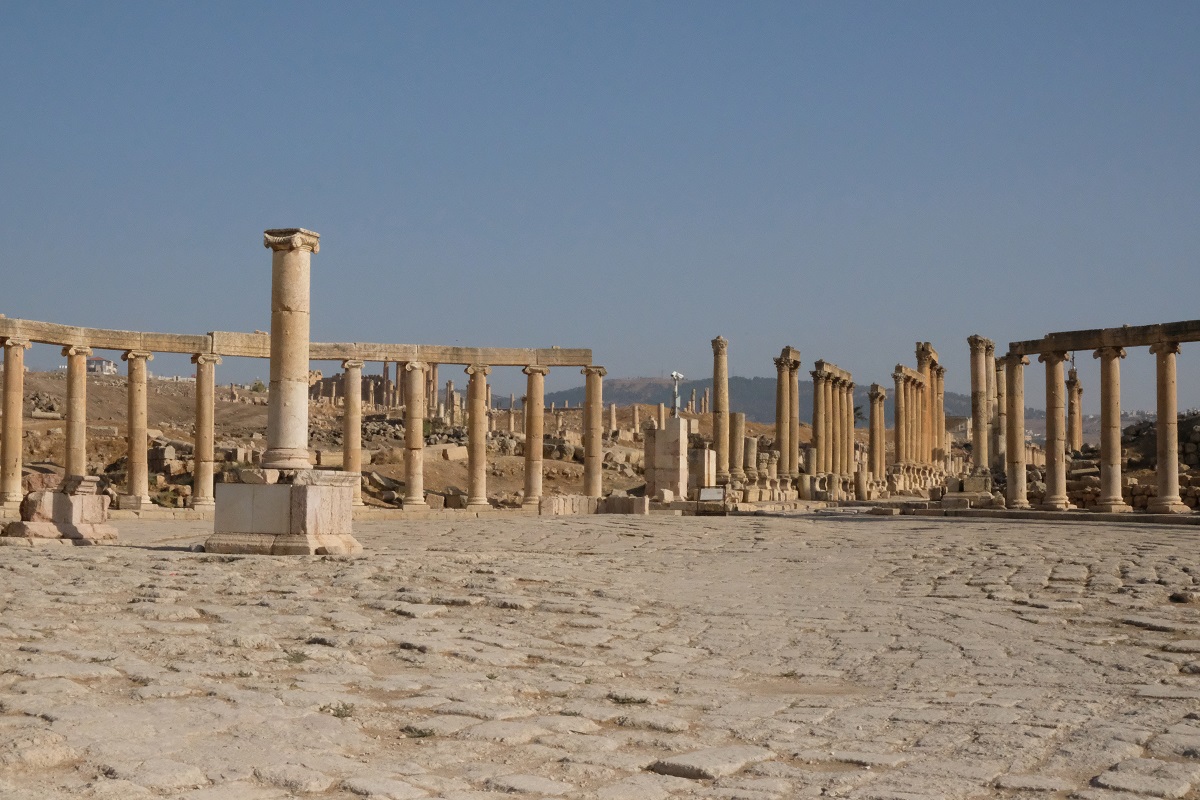







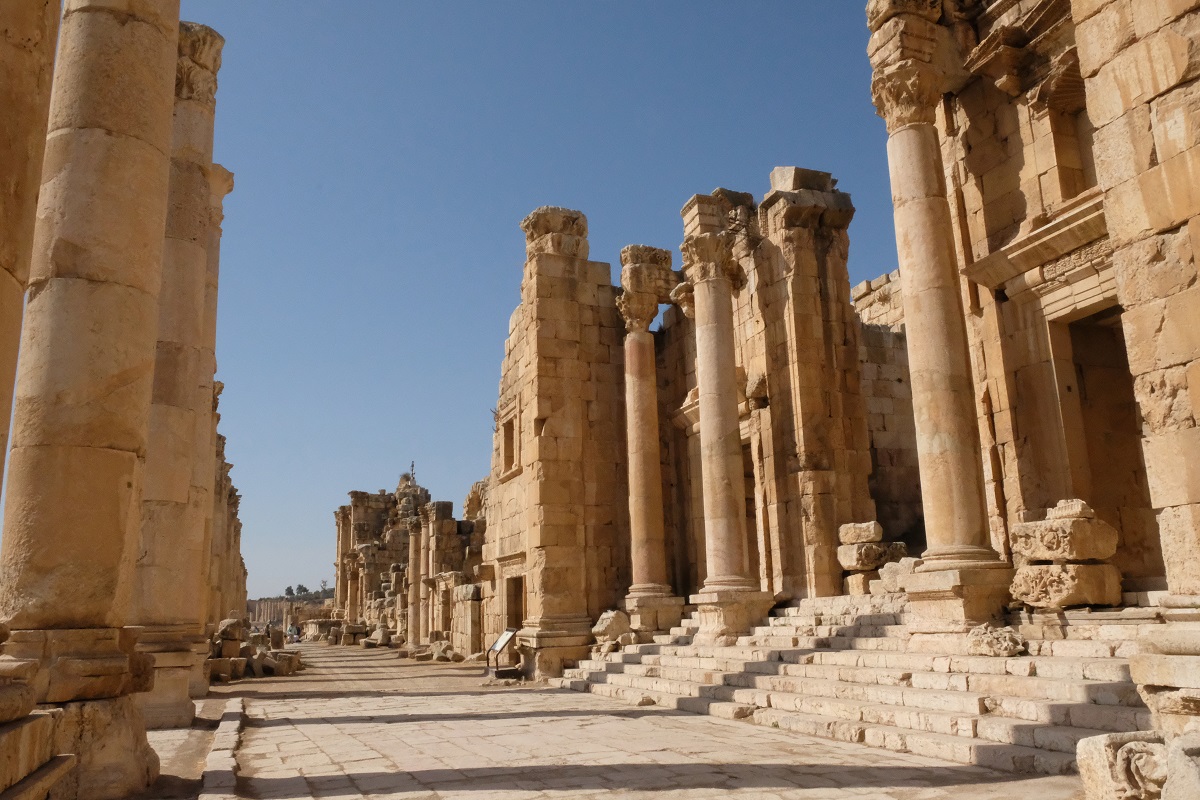







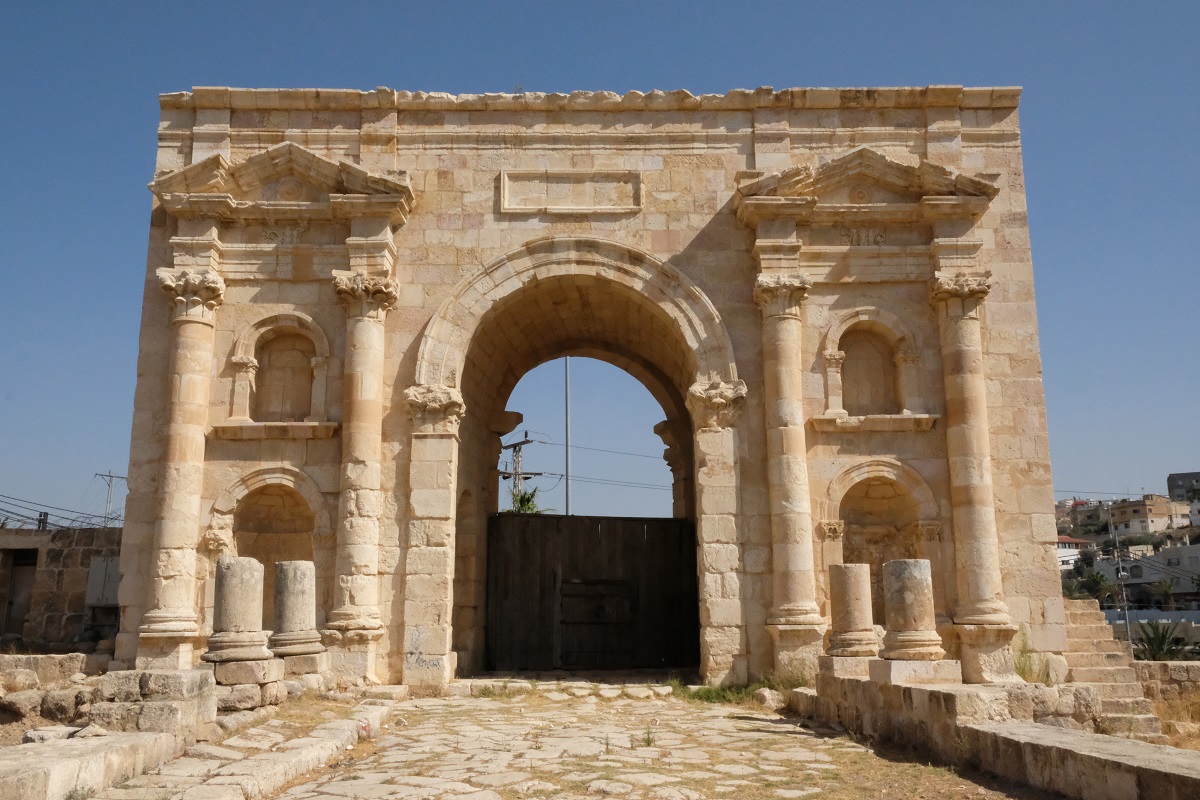

Such a great and informative write up Bama! I was too lazy on my post to write it all up! Lol. Did you hear about the “terror” attack that happened here this week??? Some tourists got stabbed! So sad
LikeLiked by 1 person
Actually writing this post was quite challenging because I wasn’t sure how I should put everything together about Jerash. I did hear about the incident — when such thing happens in a place I know or I’ve been to, it makes me even more sad and angry at the same time. I hope what happened a few days ago won’t deter people from going to Jerash.
LikeLike
Agreed. I was so sad for jerash especially after experiencing its magic. I hope that people will continue to visit and that tourism and jobs for Jordanians aren’t affected.
LikeLiked by 1 person
lost track of you for a while. will be seeing you more often.
LikeLiked by 1 person
Hi Charly! Yes, it’s been a while, indeed. Glad to have you back.
LikeLiked by 1 person
So much history! Thanks for sharing all the details, and great photos, of Jerash. I found the whole place fascinating, and could really imagine what it would have been like in its heyday.
When we were there it was hot hot hot too – no snakes but a couple of lizards.
Alison
LikeLiked by 1 person
I’m a lot more comfortable around lizards than snakes — I had some traumatic experiences with the latter when I grew up. I remember reading about the bagpipers in one of your posts about Jordan, and when I I was in the toilet just outside the South Theater there they were, playing the music not long enough for me to see.
LikeLiked by 1 person
Wow!! So amazing to contemplate such ancient civilizations. To wonder how on earth they physically created such huge structures without the aide of modern technology. Thanks for sharing and great images!!
LikeLiked by 1 person
That’s why I’m endlessly fascinated by those magnificent monuments built so many years ago before the advent of modern technology. Thanks for reading, Trees!
LikeLike
Thanks for this fascinating and informative journey into the past! I know very little about this part of the world and learn much as I read from all the research you do in order to write these posts. As I enjoyed the photos, I tried to imagine what it would have looked like in it’s original days filled with people living their daily lives. I wonder if there was greenery and abundant water.
In thinking about these ancient civilizations in various parts of the world, they all rise up, conquer and rule others for awhile, perhaps become the conquered, and eventually fade away into the dust of the past.
Someone will be next.
LikeLiked by 1 person
My pleasure, Marilyn! It’s interesting that mentioned about greenery. I read that some parts of the world that are barren today might have looked completely different thousands of years ago — for example the Fertile Crescent. However, some places like Petra (I will write more about this incredible place in future posts) have always faced challenges in terms of providing water to their people.
The world has definitely seen numerous great powers rise and fall over the millennia. And even today this pattern seems to be very much incessantly repeating itself.
LikeLike
Again a delight to feel as I am walking in your footsteps. When we were at Jerash a bagpiper was playing in the South theatre. Standing at the high point the acoustics were incredible.
LikeLiked by 1 person
I was a little bit disappointed not being able to see those bagpipers — I was literally at the right time, but the wrong place as I could hear them playing the musical instrument behind the high walls of the theater.
LikeLike
I did not get here while in Jordan, but it kind of reminds me of Ephesus in Turkey. (I admit to fast reading today, so you may have drawn this connection or others since you and I both like the wide range of Mediterranean ancient sites!) In any case, it looks amazing, which I say about all these warm stone Greek-inspired places!
LikeLiked by 1 person
I haven’t been to Ephesus (one day hopefully!). However, I couldn’t help but compare Jerash with another Roman site that I’ve been to: Baalbek in Lebanon. While the latter has much bigger temples, Jerash is more expansive with impressive colonnaded streets and Roman theaters. I liked them both, though.
LikeLiked by 1 person
What a grand site; the scale really is extraordinary—three theatres! Before getting to the part about multiple earthquakes I was actually marvelling at the detail on some of the monuments and the thinking that it looks surprisingly well preserved. They built things to last in those days!
LikeLiked by 1 person
I think I read somewhere that thousands of years being exposed to the elements actually made the building materials the Romans used much stronger. I don’t know whether this is true or not, but certainly today we get the impression that a lot of structures built many generations ago last longer than what we make these days.
LikeLiked by 1 person
There’s definitely something to that impression. I often think about the Roman bridge in Trier, Germany that still uses some of the original pillars to support modern day traffic.
LikeLiked by 1 person
Super post and a fantastic set of photos Bama. Like Alison, I remember the heat in that wide open site most of all😄
LikeLiked by 1 person
Madhu! It’s always nice to have you back in the blogging world. Did you go to Jerash the second time you were in Jordan? Because I remember you mentioned about the not-so-ideal visitation time to places you went to when you got the chance to return to this fascinating country.
LikeLiked by 1 person
Yes, I went both times, but on the second , I found a cool place to wait until the others returned😄
LikeLiked by 1 person
Unbelievable! This is amazing. Your journey looks like a magical experience for us. We hope someday we can go there and see with our own eyes.
Greeting from Travel Blogger Indonesia Ibadah Mimpi
LikeLiked by 1 person
Hi Redha and Dendy! The good thing about Jordan is we don’t need to get a visa in advance to go there. Hopefully you’ll get the chance to visit this incredible country in the near future!
LikeLike
wow! really? This is a good information for us.
Thank you.
LikeLiked by 1 person
You’re welcome.
LikeLike
Wonderful write up Bama
LikeLiked by 1 person
Thank you!
LikeLiked by 1 person
The architect of the old days seems to be better and more creative than the present. Oh look at the pictures, thanks for sharing.
LikeLiked by 1 person
If we were to build such structures today, with all those intricate details, they would have cost a fortune. However, it would be nice to have a lot of people today who master the art of rock carving.
LikeLiked by 1 person
O yes I very much agree with you.
LikeLiked by 1 person
This is so true. We have come a long way in medicine, technology, science, yet our buildings aren’t near as interesting.
LikeLiked by 2 people
You are correct.
LikeLiked by 1 person
Wonderful post, Bama. Jerash definitely lived up to expectations – both my aunt and mom raved about the place, and I was just blown away by its sheer size. The grooves made on the Roman-era Cardo left by century after century of continuous of continuous use also made a big impression on me. I might have seen a number of scattered Roman structures in Europe (the Colosseum and the hot-spring baths of Bath, England come to mind), but like you, visiting Jerash was my first-ever experience of a ruined Roman city.
LikeLiked by 1 person
Thanks, James. After going to Baalbek and Jerash, I do wonder when we’ll get the chance to visit Palmyra since all those places must have been connected one way or another in the past when the Romans still ruled the Levant. The IS destroyed some parts of the Syrian ancient city, but I believe it’s still worth going. And I certainly hope that in the near future restoration works will begin in this desert outpost.
LikeLiked by 1 person
It is incredible how many ancient Roman cities are still around, well at least in ruin form. Most people probably don’t even know about Jerash, and it is spectacular. I had to look up where it is just now. Thanks for taking us along with you.
LikeLiked by 1 person
And the more I learn about ancient Roman cities, the more I realize that there are so many incredible Roman ruins all over the Mediterranean. Did you know that one of the biggest ancient amphitheaters in the world is in Tunisia?
LikeLike
I did not know that, but it doesn’t surprise me.
LikeLiked by 1 person
Pingback: Madaba’s Marvelous Mosaics | What an Amazing World!
I loved Jerash! I thought the ruins were so extraordinary. Gorgeous photos Bama.
LikeLiked by 1 person
Jerash was quite impressive. My favorite viewpoint was from the Temple of Zeus where I could see the entire ancient city with its colonnaded streets, ruins, and what remains of the Temple of Artemis. And to the right is the modern city of Jerash.
LikeLike
Yes I loved the colonnaded streets. I was fascinated by Jerash.
LikeLiked by 1 person
Jerash is an amazing site and we truly enjoyed our time there. We had a special moment as the call to prayers started around the site; each mosque started their call one after the other and overlapped at one point. It was truly magical. (Suzanne)
LikeLiked by 1 person
I understand why you felt that way. I live in a Muslim-majority country and the call to prayers (adhan) is something I grew up listening to. However, when I traveled to places like Turkey, Lebanon and Jordan, I realized that in those countries adhan is generally more melodious and has softer tones than the version I’m more used to hearing back home.
LikeLike
Pingback: Petra the Magnificent – Part 2 | What an Amazing World!
Pingback: Preparing for Jordan – Don't hold your breath
Great post!! You were in Jordan only weeks after I was and it’s fun to think of two unique bloggers being drawn to the same place in the world. I absolutely loved my time in Jordan, and I can’t wait to go back. Your photography is outstanding! May I ask: did you hire a guide or travel on your own? We hired a “driver,” not a guide at all, and our driver was harassed by Jordanian tourism police everywhere we went. Just curious about that interesting and unexpected part of our trip.
LikeLiked by 1 person
I was prepared to feel “disappointed” by Jordan because of its popularity, but I ended up fascinated and mesmerized by this country and its magical places. Throughout our stay, we only hired drivers, not real guides. I don’t think ours were harassed by the police, although if that had happened I wouldn’t have known either. But I find Jordanians a lot less aggressive than their Lebanese counterparts (especially the drivers).
LikeLiked by 1 person
Yeah, we found out about some of the incidents because our driver would tell us what just happened. But we always got stopped and questioned going through checkpoints. *sigh!* Tourism is such a big part of the economy, and tour guides are required to go through so much training, that the authorities are apparently strict about preventing people who are not guides from acting as guides. So driving is just fine, but Nashat was not allowed to tell us anything about what we were seeing.
LikeLiked by 1 person
That made me think of the conversations we made with our drivers. It was mostly them asking us where we’re from and what we thought of Jordan. And we also told them how much we loved Jordanian food. When it comes to the information on places we visited, we always looked for it by ourselves.
LikeLiked by 1 person
Pingback: A Taste of the Levant: Jordan | What an Amazing World!